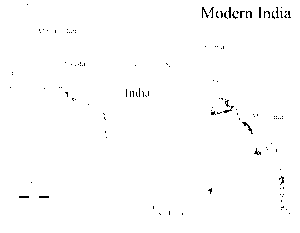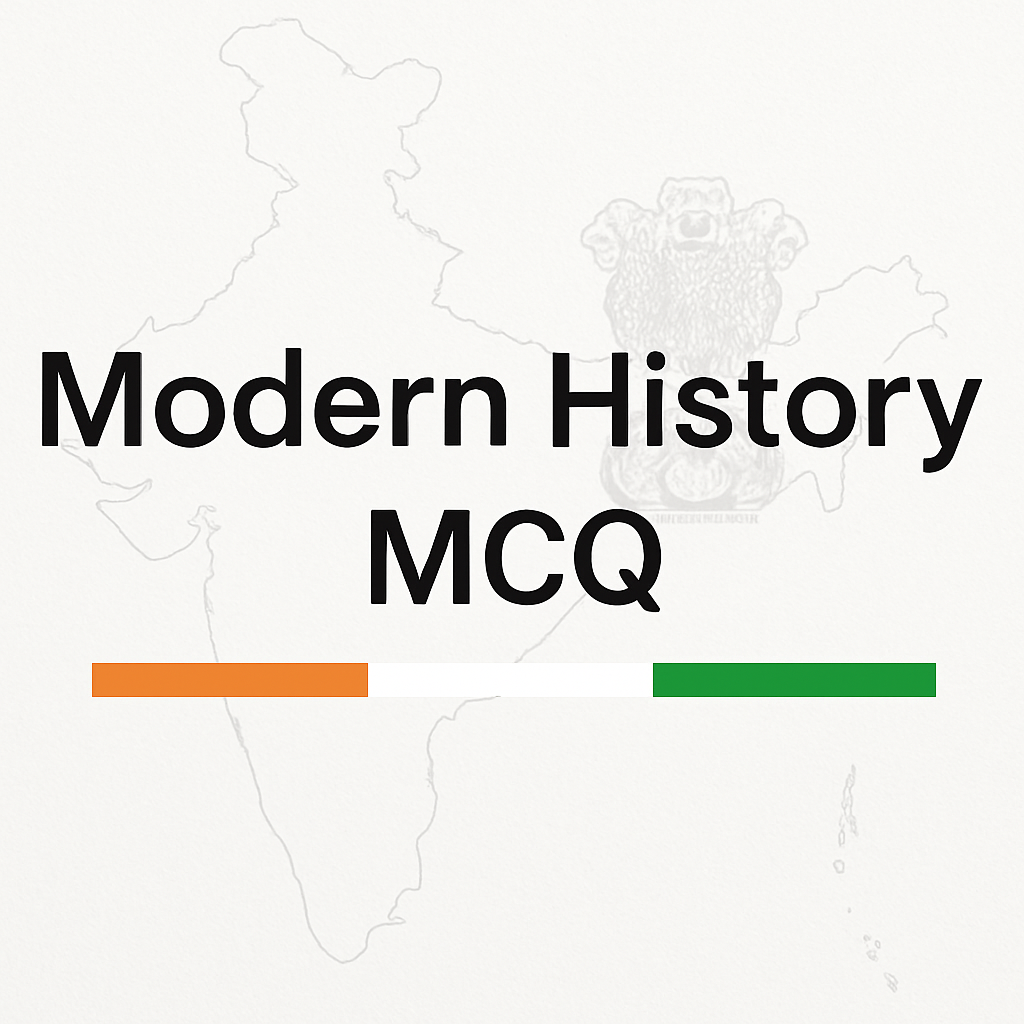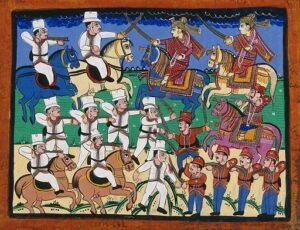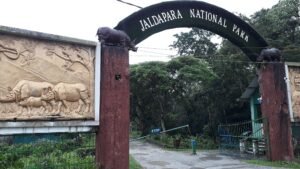Modern Indian History, spanning from the mid-18th century to India's independence in 1947 and beyond, is a crucial topic for competitive exams like UPSC Civil Services, SSC CGL, State PCS, and banking exams. This period covers the rise of British colonial rule, key reforms, freedom struggles, socio-economic changes, and the path to nation-building.
To help you test and strengthen your knowledge, we've compiled 50 important MCQs on Modern Indian History. These questions cover pivotal events, policies, leaders, and movements, from the East India Company's dominance to the framing of the Indian Constitution.

Image: No machine-readable author provided. Kmusser assumed (based on copyright claims)., CC BY-SA 3.0, via Wikimedia Commons
Modern History Mcq: practice set (50)
- The office of the Governor-General of Bengal was created by :
A) Pitt’s India Act, 1784
B) Regulating Act, 1773
C) Charter Act, 1813
D) Charter Act, 1833Show Answer
Answer: B) Regulating Act, 1773
- Which battle decisively established the Company’s political supremacy in North India?
A) Plassey (1757)
B) Buxar (1764)
C) Seringapatam (1799)
D) Assaye (1803)Show Answer
Answer: B) Buxar (1764)
- The Permanent Settlement (Zamindari system) was introduced by:
A) Lord Wellesley
B) Lord Cornwallis
C) Warren Hastings
D) Lord DalhousieShow Answer
Answer: B) Lord Cornwallis
- The Ryotwari system was introduced mainly in Madras by:
A) Thomas Munro
B) John Shore
C) Charles Metcalfe
D) Henry LawrenceShow Answer
Answer: A) Thomas Munro
- The Subsidiary Alliance system in India is associated with:
A) Lord Wellesley
B) Lord Hastings
C) Lord Cornwallis
D) Sir John ShoreShow Answer
Answer: A) Lord Wellesley
- The Doctrine of Lapse was rigorously pursued by:
A) Lord Canning
B) Lord Dalhousie
C) Lord Lytton
D) Lord CurzonShow Answer
Answer: B) Lord Dalhousie
- The immediate cause of the Revolt of 1857 was:
A) Annexation of Awadh
B) Introduction of greased cartridges
C) Heavy land revenue
D) Dissolution of the Mughal EmpireShow Answer
Answer: B) Introduction of greased cartridges
- The Queen’s Proclamation (1858) announcing Crown rule was publicly read in India by:
A) Lord Canning
B) Lord Mayo
C) Lord Ripon
D) Lord LyttonShow Answer
Answer: A) Lord Canning
- Which movement exposed the oppression of indigo planters in Bengal?
A) Deccan Riots (1875)
B) Moplah Rebellion
C) Indigo Revolt (Nil Bidroha)
D) Pabna Agrarian UprisingsShow Answer
Answer: C) Indigo Revolt (Nil Bidroha)
- The Vernacular Press Act (1878) was enacted under:
A) Lord Ripon
B) Lord Curzon
C) Lord Lytton
D) Lord Hardinge IIShow Answer
Answer: C) Lord Lytton
- The Ilbert Bill controversy (1883) occurred during the tenure of:
A) Lord Ripon
B) Lord Dufferin
C) Lord Curzon
D) Lord LansdowneShow Answer
Answer: A) Lord Ripon
- The first session of the Indian National Congress (1885) was presided over by:
A) Dadabhai Naoroji
B) W. C. Bonnerjee
C) Badruddin Tyabji
D) Surendranath BanerjeeShow Answer
Answer: B) W. C. Bonnerjee
- The Moderate–Extremist split of the Congress took place at:
A) Calcutta (1906)
B) Surat (1907)
C) Bombay (1904)
D) Lucknow (1916)Show Answer
Answer: B) Surat (1907)
- The Partition of Bengal was announced in:
A) 1903
B) 1904
C) 1905
D) 1906Show Answer
Answer: C) 1905
- The transfer of India’s capital from Calcutta to Delhi (1911) took place under:
A) Lord Curzon
B) Lord Hardinge II
C) Lord Minto II
D) Lord ChelmsfordShow Answer
Answer: B) Lord Hardinge II
- “Poverty and Un-British Rule in India” was authored by:
A) R. C. Dutt
B) Dadabhai Naoroji
C) Gopal Krishna Gokhale
D) M. G. RanadeShow Answer
Answer: B) Dadabhai Naoroji
- The Morley–Minto Reforms (1909) introduced:
A) Dyarchy in provinces
B) Separate electorates for Muslims
C) Provincial autonomy
D) A federal courtShow Answer
Answer: B) Separate electorates for Muslims
- The Lucknow Pact between the Congress and the Muslim League was concluded in:
A) 1915
B) 1916
C) 1917
D) 1918Show Answer
Answer: B) 1916
- The Home Rule Leagues (1916) were launched by:
A) Tilak and Gokhale
B) Tilak and Annie Besant
C) Besant and Lajpat Rai
D) Besant and Subramania BharatiShow Answer
Answer: B) Tilak and Annie Besant
- The Rowlatt Act was passed in:
A) 1917
B) 1918
C) 1919
D) 1920Show Answer
Answer: C) 1919
- The Jallianwala Bagh massacre occurred in:
A) Lahore
B) Amritsar
C) Delhi
D) KanpurShow Answer
Answer: B) Amritsar
- Gandhi withdrew the Non-Cooperation Movement (1922) following the:
A) Jallianwala Bagh massacre
B) Chauri Chaura incident
C) Nagpur session decision
D) Arrest of Ali brothersShow Answer
Answer: B) Chauri Chaura incident
- The Congress was reorganized on linguistic basis at the:
A) Calcutta Session (1906)
B) Nagpur Session (1920)
C) Lahore Session (1929)
D) Karachi Session (1931)Show Answer
Answer: B) Nagpur Session (1920)
- The Swaraj Party (1923) was founded by:
A) C. R. Das and Motilal Nehru
B) Lala Lajpat Rai and Tilak
C) Subhas Bose and Jawaharlal Nehru
D) Gandhi and Rajendra PrasadShow Answer
Answer: A) C. R. Das and Motilal Nehru
- The Simon Commission (appointed in 1927) was boycotted because:
A) It proposed Partition
B) It had no Indian member
C) It sought to abolish provinces
D) It supported communal electoratesShow Answer
Answer: B) It had no Indian member
- The Nehru Report (1928) recommended:
A) Complete independence
B) Dominion Status
C) Continuing diarchy at Centre
D) Separate electorates for Depressed ClassesShow Answer
Answer: B) Dominion Status
- The resolution of Purna Swaraj was adopted at the Congress Session held at:
A) Karachi (1931)
B) Madras (1927)
C) Lahore (1929)
D) Faizpur (1936)Show Answer
Answer: C) Lahore (1929)
- The Bardoli Satyagraha (1928) was led by:
A) Mahatma Gandhi
B) Sardar Vallabhbhai Patel
C) Rajendra Prasad
D) C. RajagopalachariShow Answer
Answer: B) Sardar Vallabhbhai Patel
- Gandhi’s Salt March (Dandi March) began on:
A) 26 January 1930
B) 12 March 1930
C) 6 April 1930
D) 2 October 1930Show Answer
Answer: B) 12 March 1930
- The Gandhi–Irwin Pact was concluded in:
A) 1930
B) 1931
C) 1932
D) 1933Show Answer
Answer: B) 1931
- Gandhi attended which Round Table Conference?
A) First (1930)
B) Second (1931)
C) Third (1932)
D) All threeShow Answer
Answer: B) Second (1931)
- The Communal Award (1932) was announced by:
A) Winston Churchill
B) Ramsay MacDonald
C) Clement Attlee
D) Lord LinlithgowShow Answer
Answer: B) Ramsay MacDonald
- The Poona Pact (1932) was an agreement between:
A) Gandhi and Ambedkar
B) Gandhi and Irwin
C) Nehru and Jinnah
D) Bose and SavarkarShow Answer
Answer: A) Gandhi and Ambedkar
- A key feature of the Government of India Act, 1935, was:
A) Separate electorates abolished
B) Provincial autonomy introduced
C) Complete responsible government at Centre
D) Indian veto over defenceShow Answer
Answer: B) Provincial autonomy introduced
- The Reserve Bank of India was established in:
A) 1934
B) 1935
C) 1936
D) 1937Show Answer
Answer: B) 1935
- The August Offer (1940) was made by:
A) Lord Linlithgow
B) Lord Wavell
C) Lord Irwin
D) Lord MountbattenShow Answer
Answer: A) Lord Linlithgow
- The first Satyagrahi of Individual Satyagraha (1940) was:
A) Jawaharlal Nehru
B) Sardar Patel
C) Vinoba Bhave
D) Rajendra PrasadShow Answer
Answer: C) Vinoba Bhave
- The Cripps Mission (1942) was headed by:
A) Stafford Cripps
B) John Simon
C) Pethick-Lawrence
D) A. V. AlexanderShow Answer
Answer: A) Stafford Cripps
- The Quit India Resolution (1942) was adopted at:
A) Lahore
B) Karachi
C) Bombay (Gowalia Tank Maidan)
D) AllahabadShow Answer
Answer: C) Bombay (Gowalia Tank Maidan)
- The Wavell Plan was discussed at the Shimla Conference in:
A) 1943
B) 1944
C) 1945
D) 1946Show Answer
Answer: C) 1945
- The INA trials (1945–46) were held at:
A) Fort William, Calcutta
B) Red Fort, Delhi
C) Fort St. George, Madras
D) Aga Khan Palace, PuneShow Answer
Answer: B) Red Fort, Delhi
- The Royal Indian Navy Mutiny took place in:
A) 1942
B) 1944
C) 1945
D) 1946Show Answer
Answer: D) 1946
- The Cabinet Mission Plan (1946) proposed:
A) Immediate Partition
B) A unitary Centre with residuary powers
C) A federal union with a weak Centre and provincial groupings
D) Dominion status for princely states onlyShow Answer
Answer: C) A federal union with a weak Centre and provincial groupings
- The Interim Government formed in September 1946 was headed (as Vice-President of the Executive Council) by:
A) Sardar Patel
B) C. Rajagopalachari
C) Jawaharlal Nehru
D) Dr. Rajendra PrasadShow Answer
Answer: C) Jawaharlal Nehru
- The Muslim League declared Direct Action Day on:
A) 16 August 1946
B) 3 June 1947
C) 18 July 1947
D) 15 August 1947Show Answer
Answer: A) 16 August 1946
- The date of the Mountbatten Plan is:
A) 16 August 1946
B) 3 June 1947
C) 18 July 1947
D) 15 August 1947Show Answer
Answer: B) 3 June 1947
- The Indian Independence Act received Royal Assent on:
A) 26 January 1950
B) 3 June 1947
C) 18 July 1947
D) 15 August 1947Show Answer
Answer: C) 18 July 1947
- The last Viceroy of British India was:
A) Lord Wavell
B) Lord Linlithgow
C) Lord Mountbatten
D) Lord IrwinShow Answer
Answer: C) Lord Mountbatten
- The first Indian Governor-General of independent India was:
A) Dr. Rajendra Prasad
B) C. Rajagopalachari
C) Jawaharlal Nehru
D) Vallabhbhai PatelShow Answer
Answer: B) C. Rajagopalachari
- The Constitution of India came into force on:
A) 26 November 1949
B) 26 January 1950
C) 15 August 1947
D) 9 December 1946Show Answer
Answer: B) 26 January 1950
Your modern history MCQ practice is on track. Consolidate learning with short revision sprints on national movement phases and key Acts. Retry this set after 48 hours to lock retention. Subscribe for structured practice and exam-focused updates.
Indian History MCQ : 30 Important Questions for Exams
30 Important MCQ on Indian Constitution With Answer







